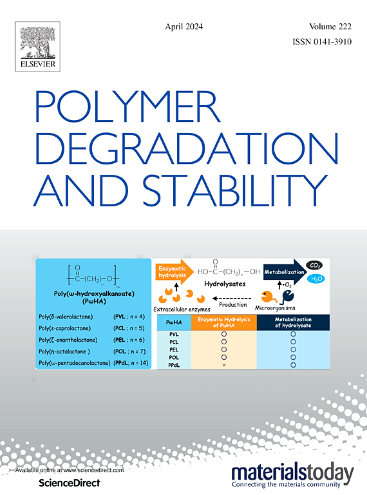In-situ generated SiO2 nanoparticles for heat release reduction and smoke suppression in unsaturated polyester composites
IF 6.3
2区 化学
Q1 POLYMER SCIENCE
引用次数: 0
Abstract
Achieving lower heat release rates (HRR) during combustion is one of the key steps toward obtaining flame retardant materials. UPR thermosets, while mechanically strong and chemically durable, show high HRR upon ignition. While most commercial applications focus on blending of metal oxide or other heterogeneous fillers to reduce HRR, they have significant drawbacks like phase segregation, drop in transparency and other features which disfavor their use in UPRs. Herein, a novel, green technique to generate nSiO2 in-situ in UPRs is demonstrated. The method is designed such that the precursors act as nucleating agents covalently bonded to the UPRs and as growth fuel for the nSiO2 production. Apart from major advantages like a uniform phase distribution in the thermoset and transparency, this technique also prevents direct handling of powdered micro or nanoparticles, leading to a safer working environment for the handling of UPRs. The physical, thermal, and mechanical properties analyzed show great promise towards flame retardant composites, as the formed nanocomposite material, with 10 wt% loading of nSiO2 demonstrates a 41 % reduction in total heat release (THR) and a 52 % reduction in total smoke release (TSR), while retaining optical transmission >90 %. On combination with commercial phosphorus containing flame retardant, ammonium polyphosphate (APP), the composite shows an even greater reduction in THR and TSR, while also being self-extinguishing. These compelling features, coupled with the safe nature of generating nanoparticles in-situ, offer substantial benefits of using this nSiO2 approach towards HRR reduction in UPR-based thermosets and advocate for their use in commercial formulations.
在不饱和聚酯复合材料中减少热释放和抑制烟雾的原位生成二氧化硅纳米粒子
降低燃烧过程中的热释放率(HRR)是获得阻燃材料的关键步骤之一。UPR 热固性塑料虽然具有机械强度和化学耐久性,但在点燃时会显示出较高的热释放率。虽然大多数商业应用都侧重于混合金属氧化物或其他异质填料以降低 HRR,但它们存在相分离、透明度下降等显著缺点,不利于在 UPR 中使用。本文展示了一种在 UPR 中原位生成 nSiO2 的新型绿色技术。设计该方法的目的是使前驱体作为成核剂与 UPR 共价结合,并作为 nSiO2 生成的生长燃料。除了热固性相分布均匀和透明等主要优点外,该技术还可避免直接处理粉末状微粒或纳米粒子,从而为处理 UPR 提供更安全的工作环境。对物理、热和机械性能的分析表明,阻燃复合材料大有可为,因为所形成的纳米复合材料中 nSiO2 的含量为 10 wt%,在保持 90% 光学透射率的同时,总热量释放量(THR)减少了 41%,总烟雾释放量(TSR)减少了 52%。在与商用含磷阻燃剂聚磷酸铵(APP)结合使用时,复合材料的总热量释放(THR)和总烟雾释放(TSR)降低幅度更大,同时还具有自熄功能。这些引人注目的特性,加上在原位生成纳米颗粒的安全性,为使用这种 nSiO2 方法降低基于 UPR 的热固性塑料的 HRR 带来了巨大的好处,并倡导将其用于商业配方中。
本文章由计算机程序翻译,如有差异,请以英文原文为准。
求助全文
约1分钟内获得全文
求助全文
来源期刊

Polymer Degradation and Stability
化学-高分子科学
CiteScore
10.10
自引率
10.20%
发文量
325
审稿时长
23 days
期刊介绍:
Polymer Degradation and Stability deals with the degradation reactions and their control which are a major preoccupation of practitioners of the many and diverse aspects of modern polymer technology.
Deteriorative reactions occur during processing, when polymers are subjected to heat, oxygen and mechanical stress, and during the useful life of the materials when oxygen and sunlight are the most important degradative agencies. In more specialised applications, degradation may be induced by high energy radiation, ozone, atmospheric pollutants, mechanical stress, biological action, hydrolysis and many other influences. The mechanisms of these reactions and stabilisation processes must be understood if the technology and application of polymers are to continue to advance. The reporting of investigations of this kind is therefore a major function of this journal.
However there are also new developments in polymer technology in which degradation processes find positive applications. For example, photodegradable plastics are now available, the recycling of polymeric products will become increasingly important, degradation and combustion studies are involved in the definition of the fire hazards which are associated with polymeric materials and the microelectronics industry is vitally dependent upon polymer degradation in the manufacture of its circuitry. Polymer properties may also be improved by processes like curing and grafting, the chemistry of which can be closely related to that which causes physical deterioration in other circumstances.
 求助内容:
求助内容: 应助结果提醒方式:
应助结果提醒方式:


